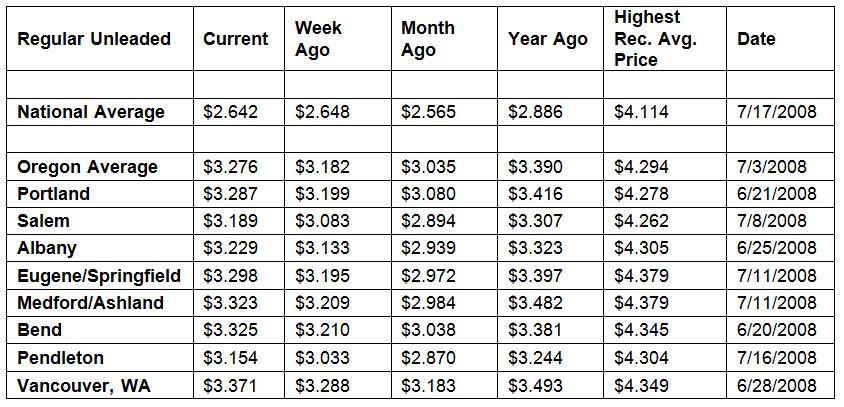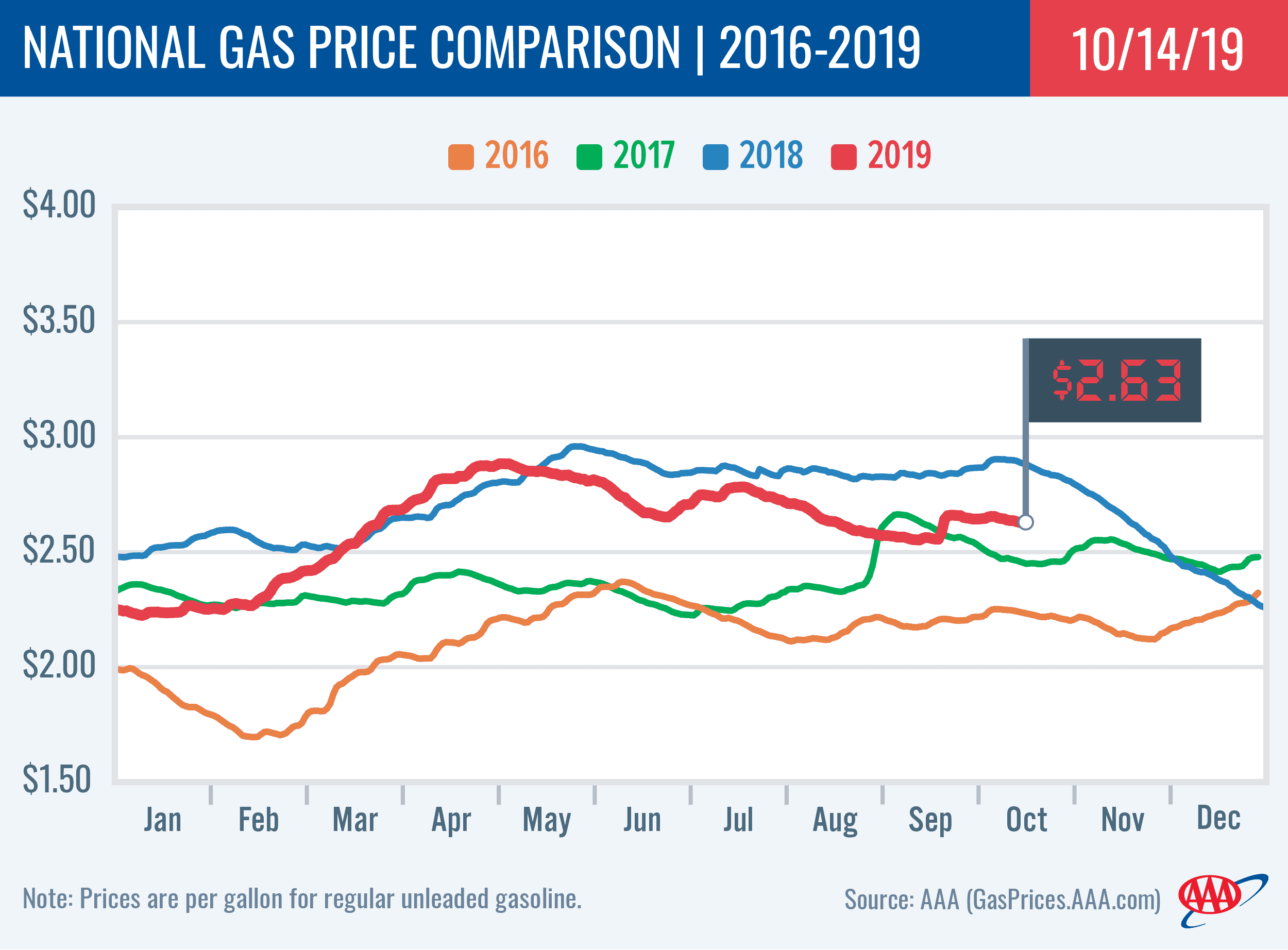Relief Expected Soon for West Coast Drivers
PORTLAND, Ore., – Pump prices are decreasing for the majority of drivers across the country as crude oil prices remain relatively low. It’s a different story on the West Coast where prices are still climbing after a number of unplanned refinery outages. Relief here should come soon. For the week, the national average for regular slips half a cent to $2.64 a gallon. The Oregon average jumps nine cents to $3.28. This is the largest weekly jump in the nation
“The national gas price average has been gradually decreasing the past three weeks and we expect this trend to continue, barring any unforeseen events such as additional refinery outages or geopolitical events,” says Marie Dodds, public affairs director for AAA Oregon/Idaho.
“Pump prices continue to soar on the West Coast but they should start to stabilize soon as supplies increase,” adds Dodds. The latest report from the U.S. Energy Information Admiration (EIA) shows the region’s refinery utilization jumped up 10 percent and gasoline stocks were relatively stable for the week ending Oct. 4, meaning there should be some relief in sight.
Oregon is one 15 states and the District of Columbia where prices are higher now than a week ago. As mentioned above, the biggest weekly jump in the nation is in Oregon (+9 cents). Washington (+7 cents) has the second-largest jump, and Indiana (+6 cents) is third. Georgia (-4 cents) has the largest week-over-week drop. Prices are flat in North Carolina.
This week there are six states with an average above $3 a gallon, up from five a week ago. California ($4.17) remains the only state in the nation with an average above $4 and has been above the $4 mark for three consecutive weeks.
Oregon is one of 35 states and the District of Columbia with higher prices now than a month ago. The national average is eight cents more and the Oregon average is 24 cents more than a month ago. This is the third-largest monthly increase in the nation. California (+54 cents) has the largest month-over-month increase and Nevada (+34 cents) is second. South Dakota (-5 cents) has the largest month-over-month decline. Prices in Missouri and Montana are flat.
Oregon is one of 48 states and the District of Columbia where drivers are paying less than a year ago. The national average is 24 cents less and the Oregon average is 11 cents less than a year ago. South Dakota (-41 cents) has the largest year-over-year drop. California (+35 cents) and Nevada (+16 cents) are the only states with year-over-year increases.
West Coast
The West Coast continues to have the highest pump prices in the nation with all of the region’s states landing on the top 10 most expensive list. A number of California refineries had unplanned outages that reduced supply over the last few weeks.
| Rank | Region | Price on 10/15/19 | |
| 1 | California | $4.17 | |
| 2 | Hawaii | $3.67 | |
| 3 | Nevada | $3.45 | |
| 4 | Washington | $3.36 | |
| 5 | Oregon | $3.28 | |
| 6 | Alaska | $3.01 | |
| 7 | Arizona | $2.91 | |
| 8 | Idaho | $2.80 | |
| 9 | Illinois | $2.76 | |
| 10 | Utah | $2.76 |
California is most expensive for the fourth week in a row, with Hawaii, Nevada, Washington, Oregon, Alaska and Arizona rounding out the top seven. Oregon is fifth most expensive for the 13th week in a row.
As mentioned above, Oregon (+9 cents) and Washington (+7 cents) have the largest weekly jumps in the nation. California (-1 cent) has the largest weekly drop in the region.
The EIA report for the week ending October 4 shows that total West Coast gasoline stocks decreased from 27 million bbl to 26.25 million bbl. This level is approximately 2 million bbl lower than this same time last year. Tighter supplies will continue to keep prices high this week, but as refineries resume normal gasoline production levels, pump prices are expected to stabilize.
The cheapest gas in the nation can be found in Louisiana ($2.26) and South Carolina $2.27). For the 35th week in a row, no states have an average below $2 a gallon.
Oil market dynamics
Crude prices fell to start this week after increasing last week after Iran announced that one of its oil tankers was struck, potentially by missiles, in the Red Sea on Friday. The incident adds to concerns that increased tension in the Middle East could lead to a disruption in global crude supply.
Crude prices also moved higher last week after reports that OPEC and its partners could deepen production cuts next year in an effort to reduce supply, which would lead to higher prices. The current production reduction agreement of 1.2 million b/d is in effect until March 2020, but when OPEC and its partners meet on December 5 and 6 in Vienna, the group could decide to deepen the cuts. Additionally, crude prices rose after the U.S. and China announced a partial trade agreement at the end of last week. However, if trade tensions return, alongside increased tension in the Middle East, crude prices could slip this week.
In related news, EIA reported that total domestic crude inventories grew by 2.9 million bbl to 425.6 million bbl last week. They now sit 15.6 million bbl higher than where they were at this time last year.
At the close of Friday’s formal trading session on the NYMEX, WTI increased by $1.15 to settle at $54.70. At the close of Monday’s formal trading session on the NYMEX, WTI fell $1.11 to close at $53.59. Today crude is trading around $53, compared to $52 a week ago. Crude prices are down about 13 percent in the last month and are about $18 per barrel less than a year ago.
Drivers can find current gas prices along their route with the free AAA Mobile app for iPhone, iPad and Android. The app can also be used to map a route, find discounts, book a hotel and access AAA roadside assistance. Learn more at AAA.com/mobile.
Diesel
For the week, the national average holds steady at $3.00 a gallon. Oregon’s average adds four cents to $3.21. A year ago the national average for diesel was $3.30 and the Oregon average was $3.46.
Find current fuel prices at GasPrices.AAA.com.
AAA news releases, high resolution images, broadcast-quality video, fact sheets and podcasts are available on the AAA NewsRoom at NewsRoom.AAA.com.
Find local news releases at https://www.oregon.aaa.com/category/news-releases/



